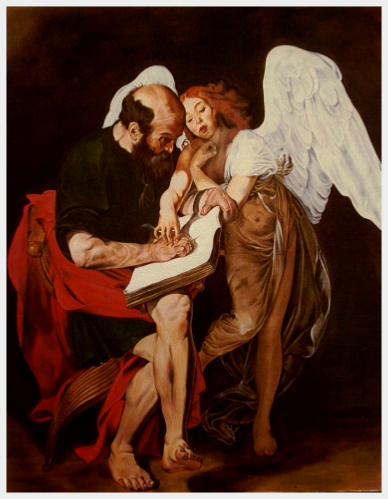



The Resurrection of Matthew and the Angel
Reviving Lost Art -
Digital Masterpieces
Great fanfare was given (and deservedly so) to Factum-
Rewind the clock back 30 years.
Hardly any of today's technology was available for use in reproducing such a refined level of art short of matching paint formulas, badger hair brushes and palette knives used in an era of the masters, 400 years ago. Even hoping to reflect accurately, the 'feel' and character of a master, with close attention to a refine deft touch and matching brush stroke application, separates a resplendent creation from the mundane. Authenticity is another subject where spectral analysis, X-
Matching a master with ‘a fine finishing touch' is a challenge. The quality of a reproduction without the original references takes research to almost “trial by ordeal” in gathering relevant information.
Old School -
Noel Baron contacted the state museum organization, Prussian Cultural Heritage (Staatlich Museen
Preussischer Kulturbesitz) inquiring about any information on obtaining a color photo, artist's copy or transparency of the Caravaggio's first rendition “Matthew and the Angle” created prior to its destruction. That original Caravaggio painting in question was destroyed in 1945 by the allied bombing of the Kaiser-
 Dr. Erich Schleier a museum director, had remarked in a letter to her that nothing in color was available but it was known and that there were a few photos in black and white possibly still available from the Staatliche Museen zu Berlin in The German Democratic Republic (East Germany)
Dr. Erich Schleier a museum director, had remarked in a letter to her that nothing in color was available but it was known and that there were a few photos in black and white possibly still available from the Staatliche Museen zu Berlin in The German Democratic Republic (East Germany)
The Staatliche Museen zu Berlin –
Kaiser-
On 21 June 1939, Hitler set up the Sonderauftrag Linz (“Special Commission: Linz”) in Dresden and appointed Dr. Hans Posse, director of the Gemäldegalerie Alte Meister, as special envoy. The Sonderauftrag not only collected art for the Führermuseum, but also for other museums in the German Reich, especially in the eastern territories.
Research indicates that Noel may have indeed been the first person to faithfully recreated the Caravaggio with the best possible descriptive input available, in color. You may see the description in German and translation in letters to Noel, supplied by the museum.
Letters -
The Details
The photographic glass plate had a crack in a corner that can be seen (right image below) – The resolution is so precise, by looking carefully, the actual individual strands of hair can be seen on Mathew as well as an undulating wave of craquelure finish reflecting the rippling age of the underlying canvas weave. The finest detail of the feathers in the angel wings are stunning and very explicit.
The finest detail of the feathers in the angel wings are stunning and very explicit.
With that information and experience in studying Caravaggio’s 3-
The Floor Anomaly
Additionally, an anomaly in the lower left corner commonly believed to be a crack or separation in the floor of the painting has been misinterpreted from the only Black and White photos that remained of the painting. In reality, a crack in the photographic glass negative plate conveyed to a print with that break causing a misinterpretation in the details of the painting’s image. A master print produced by the museum reveals the crack in such detail, that the adhesive used to join the two pieces is visible. The refractive index of the negative made the positive print appear to have a crack in the floor transposed into the final renditions of what is now, mistaken attempts to reproduced the Caravaggio accurately.
A corrected color reproduction of Caravaggio’s Matthew and the Angel is now hanging in an Oil Company executive’s home. A photo of the painting in situ is shown here.




| PRESS RELEASE SMART |
| DETAILS - CLARIFICATIONS |